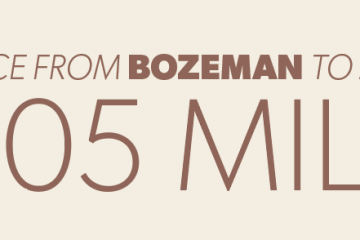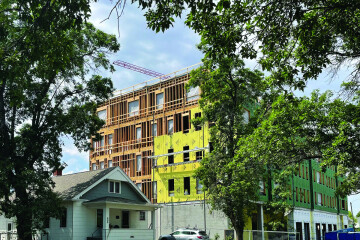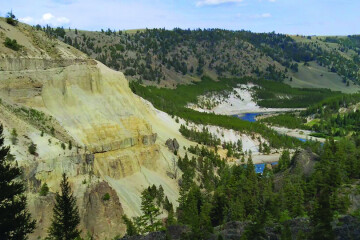What's Your Beef?: CLIMATE CHANGE On The Geological Time Scale, This Is Your Planet Suffering A Stroke
As a retired wildlife biologist, I am quite concerned with the extent and magnitude of the world-wide shift of a changing and warming climate and collapse of biodiversity and pervasive pollution now occurring. I am also concerned that a segment of our society refuses to accept the reality of a changing climate and its impact on our society and the environment in every way imaginable.
Climate Change currently ranks as one of the top media stories in today’s news reports. No argument there. We have now recently been informed that the summer of 2023 was the hottest summer in the Northern Hemisphere in the past two millennia — dating back to the height of the Roman Empire. There is conclusive scientific consensus that the global temperature increase is linked, with 99.99% certainty, to increased amounts of dangerous carbon dioxide, methane, and nitrous oxide gases released in the atmosphere, chiefly due to burning fossil fuels to power civilization. The increase in greenhouse gases serves as the primary driving force behind climate change.
Climate assessment researchers project that we will experience an annual temperature increase of 4-6 degrees F by mid-century, with an attendant host of negative ecological, economic, and financial impacts. Those temperature increases most assuredly will be damaging in the future because they’re unprecedented compared to what we’ve experienced historically. According to most scientists, the overall analysis for continued warming is rock solid, despite those peachy-sugary voices of deniers insisting that problems with the changing environment and wildlife are not anywhere as dire as gloom-and-doom environmentalists would have you believe. They argue that the majority of humans have a better quality of life than in past years. That statement certainly has an element of truth, especially with regard to medical, communication, transportation, and engineering advances, but the fact remains that, due to our activities, we humans are reshaping today’s world with a force never before experienced. Our natural resources are currently being depleted to support the swelling ranks of humanity at a rate that is unsustainable, as is the buildup of harmful waste products in crowded locales, and the spread of pollutants around the globe.
The undisputed fact is that planet Earth is changing as never before during its 4.5 billion year history. If Mother Nature had kept a diary of the happenings on planet Earth since life first appeared, and if, unlike human diarists, she had written only one page every ten thousand years, her diary today would comprise over 300 volumes, each with 1000 pages. Somewhere near page 900 in the most recent volume, she would have recorded the appearance of the first Homo sapiens (anatomically modern humans) some 350,000 years ago. The diary would have noted in the last chapter that man had achieved the ability to record and reconstruct the broad outlines of much of the history on Earth from the scraps of fossils and living vestiges.
During the passage of eons of time during the diary’s recordings in those years of man’s absence, planet Earth was subjected to climatic shifts, major geologic and oceanic changes, and massive global die-offs, including the demise of the dinosaurs’ long reign. Despite Earth’s historic upheavals, it always rebounded with an amazing plasticity. With the appearance of modern man in the last chapter of the diary, his appearance changed the equation. Today, the environmental force that has the harshest and most far-reaching impact on the natural environment has been man’s environment-modifying, pervasive and, in many cases, destructive actions that have contributed to the modification and destruction of natural habitats.
Climate, more than any other physical factor, determines whether or not a given species will live and survive in a given region. Within vital limits, a change in climate works a greater hardship on an organism. Climate is largely a matter of rainfall and temperature, and its effects may be felt by the organism directly, or indirectly. Among all the limiting environmental factors which surround and influence today’s plants’ and animals’ success or death centers on man’s activities, and climate. It is these two agents that have the capability to pull down more powerfully on the steel spring of a species’ survival. Since man has entered the equation in the bright tapestry of Earth’s destiny, we sincerely hope that we will acquire sufficient wisdom to provide refuge for the most endangered and threatened wildlife species before they, too, go the way of the passenger pigeon.
Since Homo sapiens first appeared on Earth, our biomass numbers increased at a relatively slow pace until the arrival of the Industrial Revolution, when numbers dramatically increased. During the mid-1800’s, there was a ka-boom increase in human population, similar to the exponential growth of bacteria doubling in numbers in a petri nutrient agar dish over a short period of time. Homo sapiens’ number now stands at a shade under eight billion folks, a population that continues to grow.
A rapidly changing world and declining wildlife populations captures the attention of many of us. I find it disturbing when I read a Living Planet Report stating that of every ten wild animals that roamed Earth half a century ago, only three are present today. This can’t simply be dismissed as Earth having a few disturbing decades of geological hiccups. As environmental wildlife biologist writer Douglas Chadwick aptly points out, “On the geological time scale measured in centuries and millennia, this is your living planet suffering a stroke.”
Montana currently has five endangered species and ten threatened species listed under the federal Endangered Species Act. Of the 15 species listed, 12 are animal species and three are plant species. Endangered species are defined as those in danger of extinction throughout all or a significant portion of their range. In contrast, threatened species are those likely to become endangered in the near future.
For the past five decades, Montana’s Constitution has guaranteed to each Montanan “The right to a clean and healthful environment, and the rights of pursuing life’s basic necessities; enjoying and defending their lives and liberties; acquiring, possessing, and protecting property, and seeking their safety, health, and happiness in all lawful ways.” These are fundamental rights for Montanans, not suggestions or aspirational goals. Despite these guaranteed assurances, we currently have a vocal segment of those who want to undermine the constitutionality of these rights.
Residents of Montana, over the years, have grown accustomed to picking sides in the seemingly endless polarizing arguments between pro-industry representatives and conservationists, each group labeling the other as the enemy of a brighter future. The underlying issue has always been whether people with different backgrounds and interests can work well enough with one another to create a better level of coexistence with environmental issues. Existing in a world with ever-dwindling resources and alternatives, coupled with climate change and increasing crowds of fellow Earthlings doesn’t appear to be a very fulfilling future or destiny.








